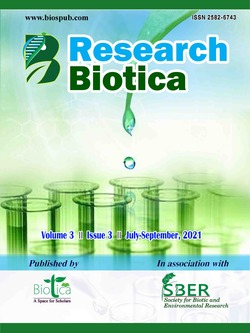
Effect of Levels and Sources of Sulphur on Nutrient Uptake, Economics and Post-Harvest Soil Nutrient Concentration of Sesamum (Sesamum indicum L.)
P.C. Lallawmzuali*
Dept. of Agronomy, SASRD, Nagaland University, Medziphema, Nagaland (797 106), India
Lanunola Tzudir
Dept. of Agronomy, SASRD, Nagaland University, Medziphema, Nagaland (797 106), India
D. Nongmaithem
Dept. of Agronomy, SASRD, Nagaland University, Medziphema, Nagaland (797 106), India
DOI: https://doi.org/10.54083/ResBio/3.3.2021.154-157
Keywords: Net return, Nitrogen, Phosphorous, Potassium, Sesamum, Sulphur
Abstract
A field experiment was conducted at the experimental farm, Department of Agronomy, SASRD, Nagaland University to study sesamum on nutrient uptake, economics and nutrient concentration on post-harvest soil as affected by different levels and sources sulphur. The experiment was laid out in randomized block design (RBD) with three replications. There were ten treatments viz., T1 (control), T2 (10 kg gypsum ha-1), T3 (20 kg gypsum ha-1), T4 (30 kg gypsum ha-1), T5 (40 kg gypsum ha-1), T6 (control), T7 (10 kg elemental sulphur ha-1), T8 (20 kg elemental sulphur ha-1), T9 (30 kg elemental sulphur ha-1) and T10 (40 kg elemental sulphur ha-1). The total Nitrogen (70.72 kg ha-1), Phosphorus (7.91 kg ha-1), Potassium (28.52 kg ha-1) and Sulphur (6.05 kg ha-1) uptake by the plant was recorded highest with 40 kg elemental sulphur ha-1. Treatment T10 recorded the highest net return as well as B:C ratio (%) with Rs. 24,130.40 ha-1 and 1.21 respectively, while T1 and T6 recorded the lowest net return and were statistically at par. The available soil Nitrogen (435.53 kg ha-1) after harvest was recorded highest in T1 (control). The available soil Phosphorus (48.75 kg ha-1) and Potassium (214.27 kg ha-1) was recorded highest in T1 (control) and available soil Sulphur (22.15 kg ha-1) was recorded highest in T10.
Downloads
not found
Reference
Anonymous, 2016. India oilseeds: Area, production and productivity. The Soybean Processors Association of India. Available at: http//www.sopa.org/india-oilseeds-area-production-and-productivity. Accessed on: 19th January, 2020.
Bray, R.H., Kurtz, L.T., 1945. Determination of total, organic and available forms of phosphorous in the soil. Soil Science 59, 39-45.
Dayanand, Meena, M.L., Shivran, A.C., 2002. Influence of intercrops and sulphur as nutrient uptake and food quality of sesamum. Indian Journal of Agricultural Science 72(10), 594-596.
Hanway, J., Heidal, H.S., 1952. Soil testing laboratory procedures. Jowa Agriculture 57, 1-31.
Raja, A., Hattab, K.O., Gurusamy, L., Vembu, G., Suganya, S., 2007. Sulphur application on growth and yield and quality of sesame varieties. International Journal of Agricultural Research 2(7), 599-606.
Subbiah, B.V., Asija, G.L., 1956. Rapid procedure for the estimation of available nitrogen in the soils. Current Science 25, 259-260.
Tabatabi, M.A., Bremner, J.M., 1970. Comparison of some methods for determination of total sulphur in soil. Soil Science Society of America Proceeding 34, 417-420.
Vaijapuri, V., Amuda, A., Sriramachandrashekaren, M.N., Ravechandran, M., 2003. Effect of sulphur levels on seed quality and nutrient uptake of sesamum. Advances in Plant Science 4(3), 327-330.
Zhao, A., Guo, A., Liu, Z., Pape, L., 1997. Molecular cloning and analysis of Schizosaccharomyces pombe Reb1p: Sequence-specific recognition of two sites in far upstream DNA intergenic spacer. Nucleic Acids Research 25(4), 904-910.
